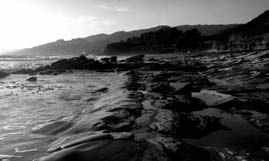The Last Jewel of Southern California
On a crisp spring morning, photographer Brett Leigh Dicks and I set out to document the diverse environment and open expanse of the Gaviota Coast. Arriving at Refugio State Beach just after sunrise, we encountered children playing where a chilly creek flowed into the ocean, flocks of sea birds twisted and turned just above the surface of the waves, dolphins dipped above the waves close to shore and surfers enjoyed a small break. As one surfer with a longboard strolled past, he noticed Brett intently photographing in the sunrise-drenched light and yelled behind him, “Don’t tell anyone where you took the photos!” This is one secluded location that needs to be revealed – if only to protect it from a pending development which threatens to destroy its integrity as an environment so far untouched by the invasive hand of urban sprawl.
Will the American dream of urban sprawl destroy one of the last untouched areas of biodiversity on the southern Californian coast?
Just north of Santa Barbara sit 30 miles of the Gaviota Coast, an environmental treasure and the last remaining jewel of undeveloped land in Southern California. It is a prime example of an undisturbed
Mediterranean environment and one of only five representatives of this type of ecosystem worldwide. The Gaviota Coast has an ancient connection to the Native American Chumash, being home to one of the oldest indigenous settlements in North America. It was also an integral part of the mission system and Mexican land grants. Even so, the inaccessibility of large tracts of land leading north to the Santa Ynez Mountains has allowed this area to remain a wilderness undisturbed by fences, freeways or urban streets. Zoned rural, this in part is what has helped protect its biodiversity and sustain the associated marine habitat.
To signify its biological diversity, the United Nations lists the Gaviota Coast as one of the world’s top 15 ecological wonders, home to more than 195 species of birds, 60 species of fish and 1,400 other plant and animal species. The sanctuary is a refuge for the critically endangered southern steelhead trout and the red-legged frog, as well as another 24 resident species which are currently federally listed as threatened or endangered. Another 60 species linger just outside the line that would mark them as officially threatened or endangered.
From canyons to plains to mountains, the breathtaking Gaviota coastline is filled with sycamores, willows, sage scrub, shimmering golden grasses and a carpet of wildflowers.
More than 30 freshwater creeks gently cascade into pebbled streams from the Santa Ynez Mountains into the Pacific Ocean, contributing to the clean and productive waters off the coast. It makes for some drama: in the summertime, one of the largest herds of blue whales in the world congregate in the waters of the offshore Channel Islands to feed on krill. The dense concentrations of these plankton are a result of the area’s unique and biologically diverse point of marine confluence, caused by the meeting of two major oceanic currents and the shape of the continental shelf at Point Conception. The Channel Islands fill the landscape with their silhouette, and offer an irresistible temptation to those who wish to claim this view as their private backyard.
With this unspoiled jewel in mind, a canny developer recently claimed an 1888 map of an imagined subdivision of Naples (named for Italy, but located here on the Gaviota Coast). In 1995, after a protracted legal battle, Santa Barbara County was forced to recognize 274 mansion-style lots on the site. This galvanized the community to fight the legal exception to the agricultural zoning of the Gaviota Coast, thus spurring the formation of the Naples Coalition, which was established in 2003 with the aim of protecting the region’s rural character and environmental qualities.
As the land of the Gaviota Coast pulses and breathes, free of the undeterred urban human footprint, it leaves us to ponder if it still has a chance to glisten in the light like a rare jewel, or will it be tarnished by those who seek to develop this environmental bastion.
More information about the Naples Coalition can be found at http://www.savenaples.org.
Natalie D-Napoleon is a musician and writer who lives in Santa Barbara, California and Perth, Australia. http://www.nataliednapoleon.com
Brett Leigh Dicks started off life as a photographer and he continues to pursue a view of life through a camera’s lens. http://www.brettleighdicks.net
By Natalie D-Napoleon
Natalie D-Napoleon is a yogi, songwriter and writer from Fremantle, Australia who now lives in California. She has an MA in Writing and works as a Coordinator at a Community College Writing Center. Her writing has appeared in Entropy, Australian Poetry Journal, LA Yoga and Writer’s Digest. In 2018 she won the Bruce Dawe National Poetry Prize (Australia).



